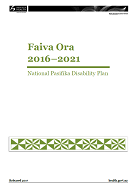Faiva Ora 2016–2021 sets out priority outcomes and actions to support and improve the lives of Pacific disabled people of all ages and their families.

Summary
Approximately 6 percent of people who were allocated Ministry-funded disability support and services in 2016 identified as Pacific peoples. Yet, overall, Pacific disabled people remain under-represented in disability support services. Factors that contribute to this under-representation include: a limited choice of culturally responsive disability services and negative traditional Pacific views of disability.
To address this under-representation, the Ministry of Health Disability Support Services have been working with Pacific disabled people, Pacific communities and disability support services to develop the Faiva Ora National Pasifika Disability Plan 2016–2021.
The plan focuses on:
- improving outcomes for Pacific disabled children, youth and their families
- encouraging Pacific communities to better engage with and support individuals with disabilities and their families to participate in their communities
- ensuring disability services and supports meet the needs of Pacific disabled people and their families
- encouraging stakeholders to work in partnerships to address challenges experienced by Pacific disabled people and their families.
Updated August 2017
Two amendments were made to the Action 1.7 and Action 1.8 outcome descriptions. This was to distinguish more clearly the difference between 'circles of support' and 'community conversations'.
